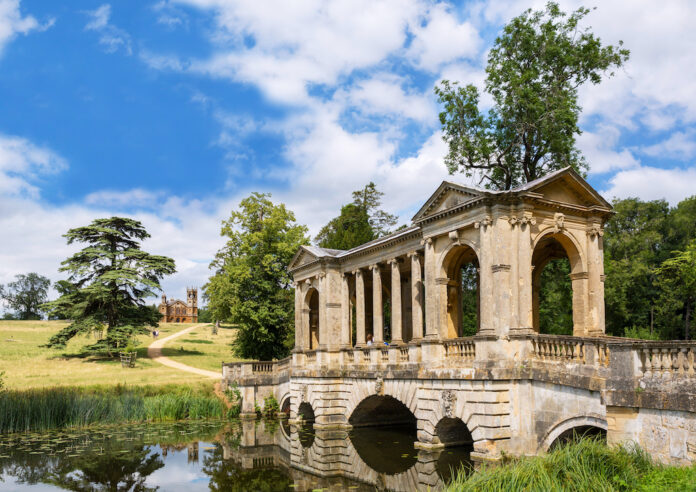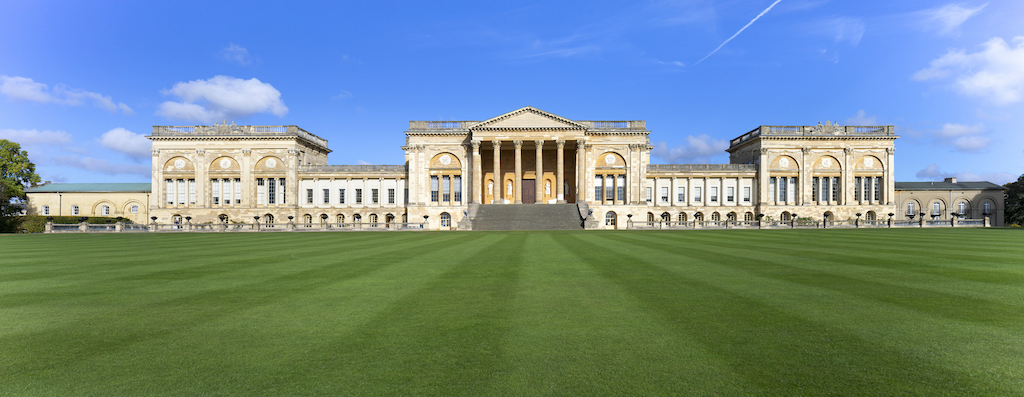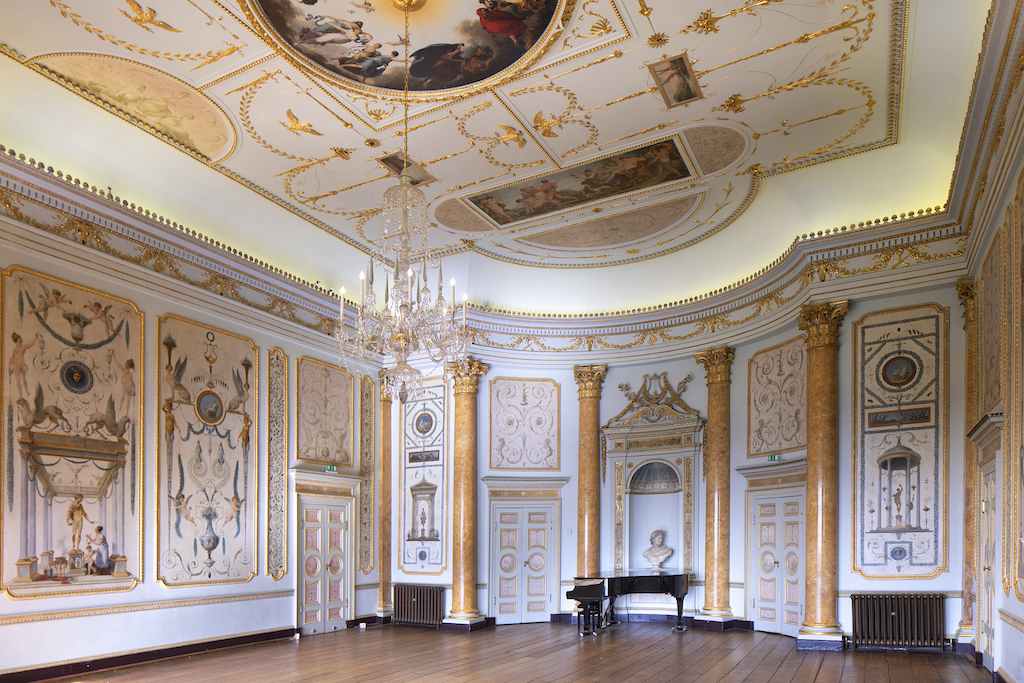
Stowe House is a stately home with a difference, where schoolchildren work alongside conservators to keep its spirit alive
Today, visitors to Stowe House travel along the tree-lined Stowe Avenue from Buckingham, northeast of Oxford. En route they pass Thomas Pitt’s golden Corinthian Arch and the reconstructed 18th-century coaching inn, now a National Trust visitor centre, first glimpsing Stowe House beyond Bell Gate Drive.
This is the same approach that tourists and esteemed guests have taken for 300 years. On 15 January 1845 it was Queen Victoria’s turn: “We drove a great way round through the Park till we came to the immense house, which is quite like a Palace,” she wrote in her journal. “There is a large flight of steps in front, with long colonnades on either side.”
Home to the Duke of Buckingham and Chandos at the time, Stowe House was indeed a ducal palace. Its grandeur and ‘immense’ size reflect this. It boasts the country’s longest enfilade of state rooms, running for one sixth of a mile. When all the doors are open you can see from one end of the house to the other – an ideal piano nobile for hosting parties.

But the pomp and ceremony did not last, and Stowe’s demise was more dire than most. From the 40-plus temples and monuments in the gardens to the many intricate murals within the house, the large majority of the estate you see today has at some point over the past 30 years demanded the attention of either Stowe House Preservation Trust, who have owned and restored the house since 1997, or the National Trust, who were gifted the 250-acre landscape gardens in 1989. Together they maintain a unified front for restoring the magnificence at Stowe, first honed more than 300 years ago and saved by the creation of Stowe School in 1923.
It was the Temple family who built the original, central block of the house between 1677 and 1683 to the design of William Cleere, Sir Christopher Wren’s master joiner. Over the following 150 years it would grow into Europe’s largest privately owned Neoclassical building. Most notably from 1697, its fifth owner, British soldier and Whig politician Richard Temple – who later became Viscount Cobham – employed some of Britain’s most famous architects and garden designers to execute his imaginative vision. Sir John Vanbrugh, Thomas Pitt and William Kent all played a part in Stowe’s distinctive north and south facades, while James Gibbs, Vanbrugh and Kent worked alongside Charles Bridgeman and Lancelot ‘Capability’ Brown to elevate the surrounding land into expansive, trail-blazing landscape gardens.

The estate was passed on to Cobham’s nephew, Richard Grenville, whose descendants were later bestowed the Dukedom of Buckingham and Chandos. Yet it wasn’t long before the Temple-Grenville family’s bold financial and political ambitions mutated into something more insidious: greed.
In 1827 the 1st Duke of Buckingham and Chandos closed Stowe House, escaping on a yacht with more than a million pounds of debt. It was the 2nd Duke who had the honour of welcoming Queen Victoria and Prince Albert, and he threw his fancies and thousands at the affair, buying new furniture that he couldn’t afford. Before the decade was out, bailiffs had broken into the house and taken everything they could get their hands on, culminating in a 40-day auction at Christie’s. Sadly, this was the beginning of the end – but only of that particular chapter.

Stowe has a remarkable ability to regenerate. Several sales of the estate’s contents punctuated the next century, until in 1923 its new and current owners moved in. Stowe School rapidly transformed the palace into a series of classrooms and dorms. Today, its lucky pupils live and work in the now restored state rooms, where influential political players, aristocrats and royals once paraded. There can’t be a more glamorous desk at which to struggle through a piece of maths homework than those in Stowe’s gilded, galleried State Library.

Stowe House Preservation Trust (SHPT) has helped smooth the edges of this extraordinary time warp, a job that has presented unique challenges. In 2003 conservators restoring the Marble Saloon made some unusual discoveries when scaffolding afforded them a closer look at the ornate ceiling. Some details of the frieze had gone AWOL; it transpired that some Old Stoics (former pupils) had gained access to the dome and shimmied precariously around its narrow ledge, pulling off plaster limbs and moving spears. During daily assemblies, which occurred in the Saloon, it had amused the boys to ‘spot the difference’. The conservators replaced the missing sections, and a tennis ball, which had been placed between two coffers, was an unexpected find, retained for its historic value. Any of Stowe’s knowledgeable volunteer tour guides can point out this concealed nugget of Stowe’s history – and there are many more like it.
At the time of writing, SHPT’s House Custodian Anna McEvoy and her team are embarking on the restoration of the Western Suite, the final three major state rooms comprising the State Dining Room, The Small Dining Room and the State Drawing Room. “We try to restore the rooms to around the year 1800, give or take 10 years either side, because that was the peak of the family’s power and fortune,” Anna explains. A concept of what the room would have looked like is outlined with the help of historic guidebooks, illustrations, journal entries, paint analysis and consultations with experts, who advise on contemporary Georgian style.
This research can take years, and then there are two further but equally fundamental questions: what is practical, considering the house is also a working school, and how the required funds can be raised via donors and grant-making trusts.
The current project to restore the State Drawing Room has already seen the ceiling regilded; deciding on the remainder of the scheme was more difficult. A watercolour painting by Joseph Nash, a memento for Queen Victoria after her 1845 visit, shows the walls swathed in a rich red silk damask, but not only is this depiction too late
in the century, damask is not a sensible choice for a room routinely used as an overflow school canteen. “We’re going with a pink, gilded ceiling and orange wallcoverings,” says Anna. “It will certainly look unusual to modern eyes, and it may also have been unusual in the late Georgian period, but the evidence suggests that this is what it would have looked like in 1800.” The room is set to be finished in April this year; by now pupils are accustomed to eating their meals beneath scaffolding
and conservators at work.
When asked what makes Stowe House special, Anna replies instantly: “It’s not a museum. It’s not caught in time,” she says with a smile. “The school makes it a living, breathing place, filling all 400 rooms of the main mansion and more. It is fully lived in. And fully loved. We are proud that today’s visitors can still follow in the footsteps of the house’s 18th-century tourists.”
The spirit of Stowe lives on in every pupil and visitor that passes through its hallowed halls. A day visit is reminder enough that time does not stand still. Yet as Stowe successfully demonstrates, it is possible, and beautiful, to give history a home in the future.
Book ahead
House tickets are released one week before the date of the visit and can be booked online; please note you cannot book on the day. A 20-minute ‘taster tour’ or 45-minute ‘full story tour’ is included in the price, though during school holidays visitors can also choose to explore at their own pace. www.stowe.co.uk/house
Stowe’s spectacular gardens are National Trust-owned and remain open at this time, though advance booking is required. Garden admission applies to anyone visiting Stowe House unless you have pre-arranged house-only access. www.nationaltrust.org.uk/stowe





 © 2024
© 2024